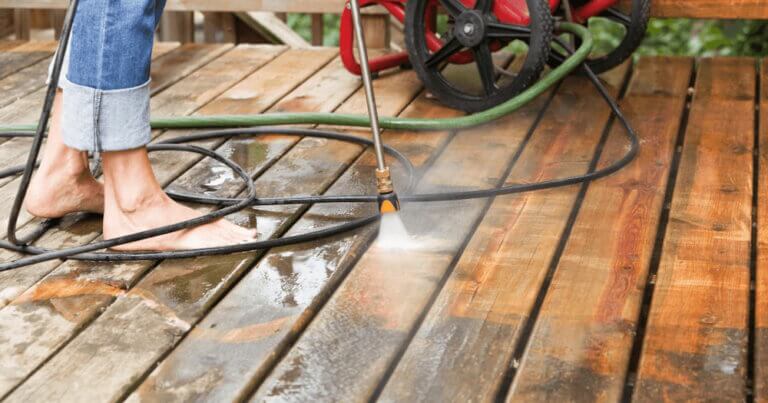One of the best ways to enhance the beauty and appeal of your outdoor space is by treating your deck. But with so many options available, it can be challenging to decide which treatment will be best suited to your needs. In this comprehensive guide, we’ll explore the differences between painting a deck and staining it, helping you make an informed decision for your outdoor space.
Key Takeaways:
- Understanding the differences between painting and staining a deck is crucial when deciding on the best treatment for your outdoor space
- Painting a deck offers a range of benefits, including increased durability, protection against moisture and UV rays, and the ability to customize the color and appearance
- Staining a deck provides a more natural look, enhances the wood’s natural beauty, and requires less maintenance than paint
- Durability and maintenance requirements are essential factors to consider when deciding between painting and staining
- Consider your deck’s specific characteristics, such as its design, environmental conditions, and intended use, to determine the most suitable option for you
Understanding the Differences
When it comes to deck treatment options, two of the most popular choices are painting and staining. It’s important to understand the differences between these two options to determine which one suits your needs best.
The Differences Between Painting and Staining
Painting involves applying a thick layer of paint to the deck’s surface, creating a barrier that seals out moisture and UV rays. Staining, on the other hand, penetrates the wood’s surface, enhancing its natural beauty and providing protection from the elements.
Benefits of Painting
Painting your deck offers several advantages, such as increased durability, longevity, and customizable color options. Additionally, the thick paint layer provides an extra layer of protection against moisture and UV rays.
Benefits of Staining
Staining lends a natural look that enhances the wood’s features, and it requires less maintenance than painting. The stain penetrates the wood fiber, offering optimal protection from moisture while retaining the natural beauty of the wood.
| Painting | Staining | |
|---|---|---|
| Application method | Brush or roller | Brush, roller, or sprayer |
| Appearance | Opaque, even color | Transparent, natural grain visible |
| Maintenance | Requires frequent touch-ups and repainting | Requires less maintenance |
| Durability | Long-lasting with proper maintenance | Long-lasting with proper maintenance |
As you can see, painting and staining offer unique benefits and drawbacks. Understanding these differences is essential to figure out which one is suitable for your deck.
Benefits of Painting a Deck
If you’re looking for a way to give your deck a fresh and updated look, painting could be an excellent option. Not only can paint conceal any imperfections in the wood, but it also offers a range of benefits that make it a popular choice among homeowners. Here are some of the advantages of painting your deck:
- Increased durability: Deck paint forms a protective coating that helps shield the wood from the elements, including moisture, mildew, and UV rays.
- Customizable appearance: With deck paint, you’ll have almost limitless color options to choose from, allowing you to match or complement your home’s color scheme.
- Enhanced safety: Paint can create a slip-resistant surface, reducing the risk of injury from falls on wet or damp surfaces.
- Easier to clean: Painted decks are easier to clean than stained decks, requiring only a mild soap and water solution to remove surface dirt or debris.
- Coverage: Paint typically provides better coverage than stain, making it a more economical option for larger decks or if you’re drastically changing the color of your deck.
Overall, painting your deck can be a great way to add some personality to your outdoor space while ensuring that it is well-protected from the elements. However, it’s important to note that paint can chip over time and may require touch-ups or repainting more frequently than stain.
Considerations for Staining
Staining a deck is a great option if you want to retain the natural look of the wood while offering protection. However, there are some essential factors to keep in mind before committing to this option.
Type of Wood
Not all woods are suitable for staining, so it’s crucial to choose the right one. Hardwoods like redwood, cedar, and ipe are ideal for staining as they absorb the stain better and last longer. Softwoods like pine or spruce are less suited to staining as they don’t hold the stain application and can deteriorate faster.
Climate
The climate where you live can impact the durability and effectiveness of your staining. If you live in an area with high humidity or precipitation, you may need to apply extra coats of stain to provide sufficient protection against mildew or rot. In dry and sunny conditions, however, the stain can dry up faster, making it more challenging to apply it evenly.
Desired Finish
The type of finish you want can have a significant impact on the color and appearance of the stained deck. Some stains offer a translucent finish, allowing the natural grain of the wood to shine through. Others offer a more solid finish, providing a more even coating of color. Before picking the stain, decide on the desired finish that will best match your outdoor space design.
Deck Stain Options
| Deck Stain | Advantages | Disadvantages |
|---|---|---|
| Semi-Transparent | -Enhances natural wood grain | -Shorter lifespan than solid stains |
| Transparent | -Easy application | -Limited UV protection |
| Solid Stain | -Effective UV protection | -May peel or crack over time |
| Clear Stain | -Protects wood without changing color | -Short lifespan |
There are different types of deck stains available, each with unique advantages and disadvantages. Transparent and clear stains offer the most natural look, while solid stains provide better protection against UV rays. When selecting the deck stain, consider the type of wood, climate, and desired finish.
Step-by-Step Guide to Painting a Deck
If you’ve decided to paint your deck, you’ll need to follow a step-by-step process to ensure a successful outcome. Here’s how:
Step 1: Prepare the Surface
Start by ensuring that your deck is clean, dry, and free of any loose or peeling paint. Use a pressure washer, deck cleaner, and sandpaper to prepare the surface for painting.
Step 2: Choose the Right Paint
Select a paint that is specifically designed for decks and outdoor use. Oil-based paints are more durable but take longer to dry, while water-based paints are easier to clean and dry faster.
Step 3: Protect Surrounding Areas
Cover any surrounding areas, such as plants or nearby furniture, to protect them from paint splatter or drips.
Step 4: Apply Primer
If your deck has never been painted before, apply a primer coat to the surface before applying the final paint color. This will ensure better adhesion and durability.
Step 5: Apply Paint
Use a paint roller or sprayer to apply an even layer of paint to the deck surface. Work in small sections, being careful not to leave any overlapping brush or roller marks.
Step 6: Allow to Dry
Allow the paint to dry completely before applying a second coat (if necessary) or allowing foot traffic on the surface.
Step 7: Maintenance
To prolong the life of your newly painted deck, regularly clean it with a deck cleaner and protective sealer. Touch up any chips or scratches with matching paint as soon as they appear.
Step-by-Step Guide to Staining a Deck
If you’ve decided to stain your deck, follow these steps to achieve a beautiful and long-lasting finish:
- Prepare the surface: Before staining, make sure your deck is clean, dry, and free of debris. Use a deck cleaner and power washer to remove dirt, dust, and mildew.
- Choose the right stain: Select a stain that aligns with your desired color, wood type, and climate conditions. Consider factors such as opacity, UV protection, and water resistance. Consult with your local hardware store expert if unsure.
- Test the stain: Test a small area of your deck with the chosen stain to ensure it’s the right color. Use a brush or roller to apply the stain evenly, and let it dry for at least 24 hours before proceeding.
- Apply the stain: Apply the stain on the rest of the deck, starting from the furthest end and working your way towards an exit point. Use a brush, roller, or sprayer to ensure an even and consistent application. Apply multiple coats if needed, allowing the current coat to dry before adding subsequent ones.
- Protect the stain: After the stain has dried, apply a protective sealant to prevent moisture and UV damage. Follow the manufacturer’s instructions, and apply the sealant evenly with a brush, roller, or sprayer. Wait for the sealant to dry completely before using your deck.
- Maintain the stain: Regular maintenance is crucial to ensure the longevity of your stained deck. Clean your deck regularly, avoid harsh chemicals, and apply a new coat of stain every few years as required.
Following these simple steps will help you achieve a beautiful and long-lasting stained deck. Now, sit back, relax, and enjoy your newly transformed outdoor space!
Comparing Durability and Longevity
The durability and longevity of a deck treatment are crucial factors to evaluate when choosing between painting and staining. While both options offer protection against the elements and improve the appearance of the deck, it’s vital to understand how they differ in terms of their ability to withstand foot traffic, weather conditions, and overall wear and tear.
| Deck Durability | Deck Lifespan | |
|---|---|---|
| Painting | Paint provides added protection against moisture, UV rays, and mold, making painted decks more durable over time. | The lifespan of a painted deck is generally shorter than that of a stained deck, lasting around five to eight years before requiring a repaint. |
| Staining | Stain penetrates the wood, offering a more natural appearance and maintaining the wood’s integrity. | A well-maintained and regularly sealed stained deck can last up to 15 years or more, making it a more durable option over time. |
It’s crucial to assess your long-term maintenance goals, personal preferences, and the amount of foot traffic your deck receives before making a decision. In some cases, painting may be a better option for increased durability and customization, while staining is ideal for those who prefer a more natural look and longer lifespan.
Maintenance Requirements
Maintaining your deck is crucial to its longevity, regardless of whether it is painted or stained. Regular cleaning and inspection help keep it in good condition and protect it from degradation.
Maintenance for Painted Decks
Painted decks require more maintenance than stained ones. The paint may peel or chip over time, so it’s essential to touch it up as soon as needed.
Tip: Touch up areas with a mini-roller and brush, ensuring that the paint color and quality match the existing paint.
In addition to touch-ups, painted decks require a thorough cleaning at least once a year. Use warm, soapy water and a brush to remove dirt, grime, and stains.
Tip: Avoid using a power washer as it may damage the paint and wood surface.
Maintenance for Stained Decks
Stained decks require less maintenance than painted ones. Their finish is more resistant to weathering and fading. However, they still need occasional cleaning and inspection.
Tip: Apply a fresh coat of stain every two to three years to maintain the deck’s color and finish.
Use a wood cleaner or a solution of water and oxygen bleach to clean the deck surface. Let it sit for about 20 minutes before scrubbing it with a stiff brush, then rinse with water.
General Maintenance Tips for Decks
- Inspect your deck regularly for damage, such as loose boards, nails, or screws.
- Trim trees and bushes around the deck to prevent debris accumulation and promote air circulation.
- Protect your deck from moisture by keeping potted plants off the deck surface and investing in a good drainage system.
Following these maintenance guidelines will help prevent costly repairs and extend the life of your decking.
Factors to Consider for Your Outdoor Space
Choosing the right treatment for your deck depends on a combination of factors. First, consider the aesthetic you want to achieve. Do you prefer a painted deck that allows you to customize colors and patterns, or a stained deck that highlights the natural beauty of the wood?
Next, consider your deck design, such as its size, shape, and layout. Will the treatment work well with your design and complement your home’s architectural style?
Environmental conditions also play a significant role. If you live in a humid climate, for example, you’ll want to consider a deck treatment that offers moisture resistance and protection against mold and mildew. On the other hand, if you live in a dry climate with intense sun exposure, you may want to choose a treatment that offers UV protection.
Lastly, consider the intended use of your deck. Will it be a place for hosting large gatherings, or a quiet spot for relaxation? The level of foot traffic and usage will affect the performance and durability of the treatment you choose.
Conclusion
When it comes to enhancing your outdoor space, there are several options to consider, such as painting or staining your deck. Throughout this comprehensive guide, we’ve examined the pros and cons of each option, as well as their differences, benefits, step-by-step processes, durability, maintenance requirements, and factors relating to your outdoor space.
Ultimately, the choice between painting and staining your deck depends on your specific needs and aesthetic preferences. While painting provides increased durability, protection against moisture and UV rays, and color customization options, staining offers a more natural look, enhances the wood’s natural beauty, and requires less maintenance.
By considering all the information presented in this guide, you’ll be able to make an informed decision that will help you create a beautiful and long-lasting outdoor space. Whether you choose to paint or stain your deck, proper maintenance is essential to preserving its appearance and lifespan. Remember to consider your deck’s specific characteristics, such as design, environmental conditions, and intended use, to determine the most suitable treatment option for your needs.
We hope this guide has been helpful in your decision-making process and wish you the best of luck in your deck treatment project!
FAQ
What are the differences between painting and staining a deck?
Painting and staining a deck differ in their application techniques and results. While painting creates a solid color and covers the wood’s natural grain, staining preserves the natural beauty of the wood and enhances its grain.
What are the advantages of painting a deck?
Painting a deck offers increased durability, protection against moisture and UV rays, and the ability to customize the color and appearance. It also provides a smooth, uniform finish.
What factors should I consider when staining a deck?
When staining a deck, consider factors such as the type of wood, climate, desired finish, and level of maintenance you’re willing to commit to. These elements will help determine the best staining approach for your deck.
How do I paint a deck?
To paint a deck, start by preparing the surface through cleaning and sanding. Then, choose a high-quality deck paint and apply it using a roller or brush. Apply multiple coats for optimal coverage and durability.
How do I stain a deck?
Staining a deck involves thorough cleaning and sanding before applying the stain. Choose a quality deck stain based on the wood type and desired finish, and apply it using a brush or sprayer. Allow sufficient drying time and consider applying a sealant for added protection.
How do painting and staining compare in terms of durability and longevity?
Painted decks generally have greater durability and longevity, as the paint forms a protective barrier against natural elements. Stained decks, on the other hand, may require periodic reapplication to maintain their appearance and protection.
What are the maintenance requirements for painted and stained decks?
Painted decks typically require regular cleaning, touch-ups, and repainting every few years. Stained decks demand periodic cleaning, re-staining, and sealing to prevent fading and wood damage.
What factors should I consider when choosing between painting and staining for my outdoor space?
Consider your deck’s design, the climate in your area, your desired aesthetic, and your willingness to commit to maintenance. These factors will help you determine the best treatment option for your outdoor space.





